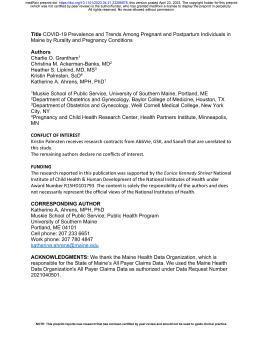
ABSTRACT
Objective: To estimate COVID-19 diagnosis prevalence and trends among pregnant and postpartum individuals in Maine by rurality and common pregnancy conditions.
Methods: We used the Maine Health Data Organization’s All Payer Claims Data to identify deliveries during 2020-2021. We identified COVID-19 during pregnancy (Apr 2020 to Dec 2021 deliveries) and during the first 6 months postpartum (Apr 2020 to Jun 2021 deliveries) using the ICD-10 diagnosis code U071 on medical claims. We used Joinpoint regression software to model trends. We stratified the analysis by rurality of residence (based on ZIP code) and by common pregnancy conditions: gestational diabetes (GDM), hypertensive disorders of pregnancy (HDP), and prenatal depression.
Results: We included 13,457 deliveries in our pregnancy and 9,143 deliveries in our postpartum analysis. COVID-19 diagnosis prevalence among pregnant individuals increased from 0.5% in Apr 2020 to 10.5% in Dec 2021 (Oct 2020 was the start of slope [0.43 per month], p<.01). COVID-19 diagnosis prevalence postpartum increased from 0.9% in Apr 2020 to 3.2% in June 2021 deliveries (slope=0.12 per month, p<.01). Trends in prevalence of COVID-19 diagnosis among pregnant individuals living in urban areas were distinct from those living in rural areas (p=.02), with a steeper slope during the first months of the pandemic in urban areas, followed by a later increase among rural residents. Trends among postpartum individuals living in urban areas were distinct from those living in rural areas (p=.03), with a steeper slope for rural residents over the course of the pandemic. Trends in persons with prenatal depression showed a steeper increase in COVID-19 diagnosis prevalence in pregnancy after Dec 2020 (p<.01) and postpartum overall (p<.01) compared to those without prenatal depression. Individuals without GDM and individuals without HDP had steeper increases in COVID-19 diagnosis prevalence in postpartum compared to those without GDM (p<.01) and those without HDP (p=.03).
Conclusion: COVID-19 diagnosis among pregnant and postpartum individuals in Maine showed distinct patterns by rurality of residence and select pregnancy conditions. This information can be used for assessing the impact of the COVID-19 pandemic on maternal and infant health.
